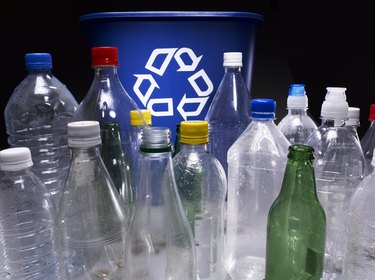Things You'll Need
Toaster oven or microwave
Pizza wheel or scissors
Heat-proof container
Heat-proof gloves
Craft stick
Plastic coloring
Glitter
Metal or soft plastic mold

Recycling plastic is good for the earth. However, recycling doesn't necessarily mean you need to take your plastics to a recycling center. Plastic is also reused to make crafts and art. By making recyclable art with melted plastic, you are keeping harmful greenhouse gases out of the atmosphere, while having fun at the same time. Melting down plastic used for recyclable art is easy, with the right equipment and melting supplies.
Step 1
Cut large pieces of plastic into small, even pieces with a pizza wheel or scissors. Place the pieces of plastic in a heat-proof container, suitable for a toaster oven.
Video of the Day
Step 2
Place the toaster oven outside or in a well-ventilated area to avoid inhalation of toxic fumes. Set the heat-proof container filled with plastic into the toaster oven.
Step 3
Set the temperature to 350-degrees Fahrenheit for soda and water bottle lids. Set the temperature to 325-degrees Fahrenheit for milk bottle lids. Set the temperature to 425-degrees Fahrenheit for bottles.
Step 4
Check the plastic consistently. Remove the melted plastic with heat proof gloves or an oven mitt. Melted plastic is not in a liquid form. It will have a sticky appearance.
Step 5
Pour plastic coloring and glitter into the melted plastic, if desired. Mix the melted plastic with a craft stick. Fill the mold with the melted plastic.
Step 6
Allow the plastic to cool and harden, approximately 15 minutes. Remove the hardened plastic from the mold.
Tip
Use a microwave if you do not have a toaster oven. Heat the plastic for 3 1/2 to 5 minutes.
Warning
Plastic bottles create a lot of fumes and do not heat well.
Video of the Day
- Knowledge Galaxy: Melting Plastic
- Tackle Making Magazine: How to Make Soft Plastic Lures
- Ridout Plastics: Frequently Asked Questions
- The Daily Green; What Do Recycling Symbols on Plastic Mean?; Brian Clark Howard
- HGTV; Melted Bead Lamp Shade and Jewelry; Margaret Carleton
- Nobel Prize: Plastics & Polymers; August 2007